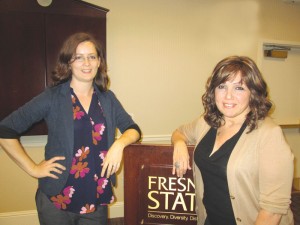
Photo: Barlow Der Mugrdechian
Michael Rettig
Editor
Studying history from the viewpoint of marginal rather than dominant actors has been one of the central focuses of social historians since the 1960s. These historians seek to add nuance to traditional histories by considering the experience of ethnic and religious minorities as well as women. On Monday, November 7, Dr. Elyse Semerdjian, Associate Professor of History and Islamic Studies and Director of Global Studies at Whitman College (Walla Walla, Washington), presented her research on “Ottoman History from the Margins: Reflections on Women and Dhimmis at Aleppo’s Shari‘a Court.” This event was organized by Dr. Stacy Fahrenthold and sponsored by the Department of History, the College of Social Sciences, and the Islamic Studies Symposia Series.
Dr. Semerdjian’s lecture challenged the dominant narrative by examining Ottoman history from the experience of prostitutes, non-Muslim women, and an Armenian convert to Islam, rather than from the perspective of the state. She stressed that traditional Ottoman history was written from an institutional framework and left little room for questioning. It essentially told the story of “what the state thought of itself.” Dr. Semerdjian was able to highlight the neglected experience of marginal groups in the Ottoman Empire by utilizing Shari‘a court registers, which were used by a wide variety of social groups for marriages, divorces, petitions, and disputes. These courts administered different laws, such as Sultanic edicts, Shari‘a, and customary law, which marginal groups were able to use to their advantage.
Dr. Semerdjian presented an example of an Armenian convert to Islam, Qamar, to demonstrate how a woman was able to manipulate the courts to improve her situation. Qamar’s husband Sarkis was absent from the country for a prolonged period, possibly on a trading venture, leaving her with no means to provide for herself. The Armenian canon code made it difficult for women to divorce, so Qamar approached the Shari‘a court and declared her desire to convert to Islam. According to Dr. Semerdjian, Qamar’s conversion demonstrated that she “investigated the law enough to know that her rights were limited.” By converting to Islam rather than petitioning for a divorce by abandonment, Qamar left the court with her marriage to her Christian husband annulled “and a higher social ranking as a Muslim woman… Convert women navigated dual legal structures to maximize benefits when and where they could.”
Dr. Semerdjian was able to use the court records to shed light on the experience of prostitutes and their place in society. Syrians in the 18th century tended to view prostitution as a societal failure, and thus prostitutes were worthy of forgiveness and reintegration into society. According to Dr. Semerdjian, the courts often punished the procurer more harshly than the prostitute, and even allowed for the prostitutes’ forgiveness. In one instance, a prostitute asked for God’s forgiveness and got married in the same document.
The third subtopic was an examination of the laws regulating Muslim and non-Muslim interactions in bath- houses. Dr. Semerdjian explained that bathing was a complex ritual because of the cleansing rules put in place to protect women’s modesty. Ottoman guilds had imposed rules separating the sexes, but they also began to separate bathhouses by religion to protect the sanctity and status of Muslim women from Christians and Jews. “When a non-Muslim woman is gazing upon a nude Muslim woman, she is gendered male because she is viewed as a conduit to the male gaze. There was the idea that she was a threat; that she might report what she had seen,” said Dr. Semerdjian.
Dr. Semerdjian noticed that these laws began to delegate more time for Muslims in bathhouses over the course of the 18th century, even in Christian and Jewish neighborhoods. She explained that the laws were created by men for women, and that women’s voices were largely absent. However, the fact that these laws were continuously reissued over the century signifies that women were violating these rules.
In utilizing the Shari‘a court laws, Dr. Semerdjian was able to use a source written by men to highlight the agency of women and other marginal groups in a historiography where they are largely underrepresented. Dr. Semerdjian’s important research adds greater nuance to the dominant Ottoman historical narrative told from the perspective of the Sultan and the State.
 Hye Sharzhoom Armenian Action
Hye Sharzhoom Armenian Action